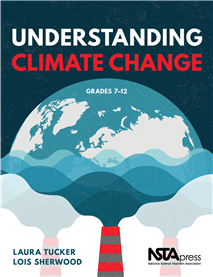NSTA Press Book Uses Three-Dimensional Learning to Help Students Understand the Effects of Human Activity on Climate Change
By Carole Hayward
Posted on 2019-06-25
For veteran science educators Laura Tucker and Lois Sherwood there is no debate about climate science. But Tucker and Sherwood realized that few books provide the much-needed assistance that teachers need to cover the scope of climate science with special attention to humanity’s role.
Tucker and Sherwood’s NSTA book, Understanding Climate Change, fills that gap and does so with “conscious attention” to three-dimensional teaching and learning called for in the Framework (for K-12 Science Education), writes NSTA Executive Director Dr. David L. Evans in the book’s forward. “The authors have made a real contribution … by providing structured suggestions that encourage students to use they science they have learned in considering the effects of human activity,” Evans said. “By making this connections, students have the best chance to use science to positively ‘affect the lives of future generations.’”
Not every secondary teacher will have received specialized climate science training, so the authors provide the much-needed text summarizing the underlying science.
The book takes students from awareness of climate change to comprehension over nine sessions, which the authors recommend being taught as a unit once between grades 7 and 12. The authors encourage science educators to decide where this units “fits best in your school or district’s scope and sequence to maximize the learning opportunities while building solid comprehension,” but urge teachers to follow their suggested time frame so that “complex topics are not shortchanged and students are allowed ample time to engage, process, and reflect.
“It is critical that the entire unit be taught with fidelity. It takes time to cover a topic as complex as climate change,” Tucker and Sherwood write.
The unit was strategically structured to engage student interest and to build a conceptual foundation without overloading learners. Scaffolding is then provided for students to conduct their own research, draw their own conclusions. The linkage and sequencing of the nine sessions allows students to build on concepts in order to better understand what comes next, thus providing a constructivist model of learning.
Each session incorporates most if not all of the following components:
- A brief overview of the session
- Clear measures to define the skills and knowledge acquired by students
- Detailed material lists (for the class, student groups, and each individual student)
- Instructions for how to prepare prior to and on the day of instruction
- Continual student reflection and re-evaluation of their learning
- Opportunities to delve deeper into session topics
- Online access to all materials used by students (data sets, rubrics, worksheets, etc.)
- Access to interviews with people working to address climate change
- Science and pedagogy to support deeper understanding of the content and process of each session
- Assessment opportunities
- Additional resources
The book’s first edition was field tested across Sherwood’s four, 10th-grade classes, and after completing this unit, a number of them formed their own group—Students for Sustainability—and affected positive changes within their school and out in their community. They even made a 6,000-mile round-trip journey, traveling from Washington state to Washington, D.C. and back, using only public transportation, to advocate for climate action. Their work is featured in Session 8.
If you’re trying to answer the question, “What’s the best way to approach the potentially controversial subject of climate change in my classroom?” the comprehensive curriculum provided in this book is an excellent resource for doing so.
Order a copy of Understanding Climate Change, here.
Check out a sample chapter, What Have You Heard About Climate Change?
Disclaimer: The views expressed in this blog post are those of the author(s) and do not necessarily reflect the official position of the National Science Teaching Association (NSTA).



